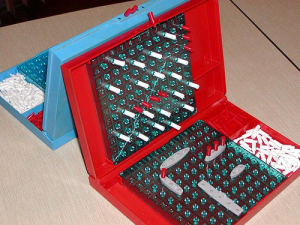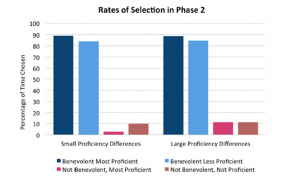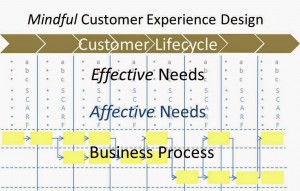Evidence suggests trust forms a barrier to churn
A competitor just introduced a new product that delivers significantly higher performance. Do you worry your customers will jump ship? If they trust you, there’s little to fear. A new study using collaborative games demonstrates people value trust far more than performance when choosing partners.
New research
 Scientists at the University of Maryland recently conducted an experiment to see how feelings of trust to guide decisions.[1] Test subjects first played an investment game in which they could keep or invest $10 with three other players. Participants learned by playing the game that one (benevolent) always returned slightly more than the player invested, another (greedy) never returned any investment, and a third (exploitative) returned slightly more than invested in first two rounds and then returned nothing.
Scientists at the University of Maryland recently conducted an experiment to see how feelings of trust to guide decisions.[1] Test subjects first played an investment game in which they could keep or invest $10 with three other players. Participants learned by playing the game that one (benevolent) always returned slightly more than the player invested, another (greedy) never returned any investment, and a third (exploitative) returned slightly more than invested in first two rounds and then returned nothing.
Then researchers asked participants to play a second game, a team version of Battleship. Subjects would choose one of the three partners from the previous game to play with them. Scientists told participants that during the game, all players would select their targets at the same time, shots would be revealed simultaneously and shot sources kept hidden, so no player knew who shot at which target or which board. At the end of the game, winners would split a $50 prize. Subjects saw a chart indicating that some potential partners were significantly more skilled than others. Faced with the challenge of maximizing their winnings, players had to choose either a better player or one they trusted.
 The scientists discovered that people were nearly eight times more likely to choose a poorly performing but trustworthy partner than an untrustworthy but highly capable one. It was as if skill didn’t matter at all; people’s subjective evaluation of trustworthiness far outweighed their objective evaluation of skill. The “halo effect,” in which one’s initial impressions of another’s character significantly influences later assessments of that person,[2] was clearly in evidence.
The scientists discovered that people were nearly eight times more likely to choose a poorly performing but trustworthy partner than an untrustworthy but highly capable one. It was as if skill didn’t matter at all; people’s subjective evaluation of trustworthiness far outweighed their objective evaluation of skill. The “halo effect,” in which one’s initial impressions of another’s character significantly influences later assessments of that person,[2] was clearly in evidence.
The game of business
This experiment suggests trust may inhibit customer churn especially when a competitor introduces a game-changing product. People are increasingly skeptical of marketing claims,[3] so given a choice of maintaining a trusting relationship or believing a sales pitch and taking a chance on an unknown supplier, customers are far more likely to stay than switch. There are limits, of course. According to prospect theory, customers seriously consider alternatives when promised benefits exceed 2:1,[4] and high churn may indicate things are worse than they appear. But high levels of trust can buy companies precious time to catch up. When companies create a base of trusting customers, simply sharing product roadmaps and allaying concerns about timelines may be all that’s needed to keep them from switching.
Conversely, the experiment shows just how detrimental betrayal can be. When companies use deceptive marketing practices, treat customers unfairly, or fail to keep promises, customers learn the company can’t be trusted and look elsewhere. This conclusion supports other research that suggests trust moderates customer loyalty.
Winning trust
People don’t immediately trust each other—they learn to trust over a series of experiences. It’s a process, and like all other processes, relationships can be continuously improved. Therefore companies can design and implement processes that increase customer attachment and lead to higher levels of trust.
 Customer journey mapping is a handy tool for improving processes. First, managers determine the sequence of events that makes up the customer experience, from becoming aware of the offering to purchasing, implementing, using, and eventually renewing or canceling the subscription. Managers then critique each touch point along the journey, looking to remedy frustrating or inefficient steps. When managers include mindful customer experience techniques in the mapping process, they uncover hidden opportunities to strengthen customer bonds along the way. They learn that managing five critical moments in the customer experience makes all the difference. As a result, companies systematically increase trust and customer loyalty.
Customer journey mapping is a handy tool for improving processes. First, managers determine the sequence of events that makes up the customer experience, from becoming aware of the offering to purchasing, implementing, using, and eventually renewing or canceling the subscription. Managers then critique each touch point along the journey, looking to remedy frustrating or inefficient steps. When managers include mindful customer experience techniques in the mapping process, they uncover hidden opportunities to strengthen customer bonds along the way. They learn that managing five critical moments in the customer experience makes all the difference. As a result, companies systematically increase trust and customer loyalty.
Intense competition and fleeting technology advantages characterize the subscription economy, so executives should expect times when their offerings lag competitors. If companies make it difficult for rivals to dislodge their customers during these times, the countermeasures will protect the company’s sustainability over the long run. Strengthening customer relationships then becomes a high stakes game, one executives don’t want to lose. Taking a systematic approach to building trust can separate the winners from the losers.
Did you enjoy this article? Subscribe to Excel-lens now and never miss another post.
Sources:
[1] Buntain, C. and Golbeck, J. (2014). Trust transfer between contexts.
[2] Thorndike, E.L.: A constant error in psychological ratings. Journal of Applied Psychology 4, 25–29 (1920).
[3] Friestad, M. and Wright, P. (1994). The persuasion knowledge model: how people cope with persuasion attempts. Journal of Consumer Research, vol. 21, No. 1, June 1994.
[4] Tversky A., and Kahneman, D. (1992). Advances in prospect theory—cumulative representation of uncertainty. Journal of Risk Uncertainty, 5, 297-323
